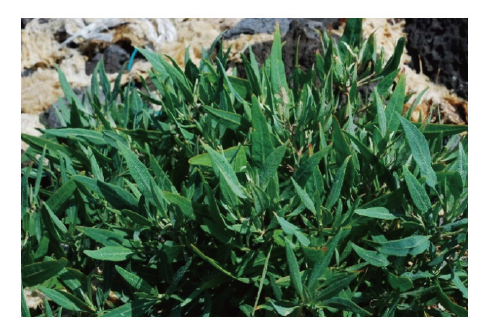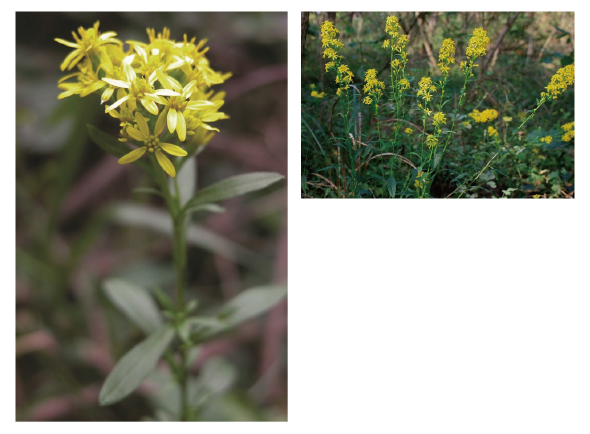서 언
잡초는 인간의 생활에 다양한 이로움을 주는 식물이다. 잡초는 경관 자원, 바이오 매스, 사면 녹화 및 토양 피복, 수질 정화 및 중금속 제거, 약용, 방향용, 식용, 사료용, 펄프용으로 사용되어 인간의 생활과 자연환경에 미치는 긍정적인 효과가 크다는 것은 주지의 사실이다. 잡초의 이용 가능성이 높다는 사실에도 불구하고 대부분의 일반인과 농업 경영인들이 인식하는 잡초는 농업 생산성을 악화시키는 해로운 식물이고, 이를 제어하기 위하여 사용하는 제초제가 인체에 해롭다는 것뿐이다. 일반인과 농업 경영인들이 잘 인식하고 있는 것처럼 잡초는 인간의 건강에 해로움을 주기도 하는데 대표적으로는 잡초가 알레르기를 일으켜 만성 질환인 알레르기 비염, 알레르기 결막염, 기관지 천식 등을 일으킨다는 것을 들 수 있다(Hong, 2015; Oh, 2007).
최근에는 기후 변화 특히 미세먼지의 증가와 꽃가루 수의 증가로 인하여 알레르기 질환이 급증하고 있는데(Burr et al., 2003; Cho, 2012; Cho et al., 2013), 꽃가루에 감작된 소아에게서 알레르기 반응이 보고되어 잠재적인 위협으로 부상하고 있다(Asher et al., 2010; Jin et al., 2011; Kim et al., 2012). 질병관리청 만성질환건강통계에 따르면 알레르기 비염에 대한 의사진단 경험율은 16.7%에 달할 정도로 많이 발생하고 있다(KCDC, 2019). 일반적으로 알레르기 반응은 서구적 식습관(Sicherer and Sampson, 2010; Wang and Sampson, 2011), 대기오염, 식물의 꽃가루 등에 의해 발생하는 것으로 알려져 있지만, 특히 잡초 중에서 알레르기를 일으키는 것으로는 환삼덩굴, 미역취, 도꼬마리, 소리쟁이, 명아주, 비름, 질경이를 들 수 있다(Hong, 2015).
잡초로 인한 알레르기는 꽃가루가 원인이 되어 상기도에서 나타나는 일련의 질환으로 꽃가루병 혹은 건초열(hay fever)이라고도 불린다. 잡초 중에서는 바람으로 수분작용을 하는 풍매화의 꽃가루가 알레르기성 결막염, 비염, 기관지염, 천식, 피부발진, 아나필락시스 반응을 일으킨다. 알레르기 질환은 쑥, 돼지풀, 환삼덩굴 등의 잡초뿐만 아니라(Oh, 2008; Park et al., 1998) 참나무, 자작나무, 편백나무와 같은 목본식물, 그리고 다양한 환경원과 음식에 의해서도 일어나며 우리나라 전체 인구의 약 20%가 알레르기에 시달린다고 추산되고는 있지만, 잡초에 의해 발생되는 꽃가루 피해에 대해서는 보고된 바가 없다.
본 논문에서 저자는 알레르기 만성질환의 원인이 되는 잡초종을 선정하여 그 특징을 설명하였고, 향후에 알레르기를 일으킬 가능성이 높은 잡초에 대한 정보를 제공하고자 하였으며, 이를 통해서 잡초방제의 중요성을 부각시키고자 하였다.
자료 추출
우리나라에서 알레르기 반응을 일으키는 전 세계 잡초에 대한 문헌정보는 강원대학교 중앙도서관에서 제공하는 Discovery 프로그램을 이용하여 전세계의 모든 생명공학 분야의 정보를 검색하였다. 국내 정보는 SCIENCEON을 이용하여 검색하였으며, 해외의 알레르기 유발 식물에 대한 정보는 PubMed, Sciecne Direct, Taylor and Francis, BMC, Wiley, Springer, ACS, Goole과 다른 문헌 데이터베이스를 이용하여 검색하였다. 외래 잡초의 위치정보는 국립생태원의 외래생물 전국 서식 실태조사(NIE, 2016)와 현장조사를 통해 수집된 정보를 취합하여 데스크탑용 ArcGIS 버전 10.8을 이용하여 전국지도에 표시하였다.
본론
알레르기
우리 인체는 외부 환경으로부터 신체를 보호하기 위해 민감하게 반응한다. 그 과정에서 손상된 조직을 정상으로 회복하기 위한 염증반응이 발생한다(Jeong et al., 2017). 이러한 염증반응이 조절되지 못하고 지속적으로 과도하게 발생하면 추후 만성 알레르기 질환을 일으키게 된다. 만성 알레르기 질환은 식물의 꽃가루, 서구적 식습관, 대기오염 등에 의해 발생하는 것으로 알려져 환경성 질환이라고도 부른다(Cho et al., 2013). 최근 서구적 생활습관과 산업화에 따른 환경오염이 극심해지면서 환경성 질환자 수가 증가하고 있다(Simon, 2019). 환경성 질환은 알레르기 비염, 천식, 아토피 피부염 3개 질환을 포함한다. 통계에 따르면 환경성질환자 수는 꾸준히 증가하고 있는데, 2019년 아토피 피부염 환자수는 2015년 92만5천명에서 2019년 94만 9천명으로 증가하였고, 알레르기성 비염 환자수는 2015년 15,054,265명에서 2019년 16,103,336명으로 증가하였다(NHIS, 2020). 우리나라에서 천식으로 사망한 환자 수만 2,023명에 달하는 것으로 보고되었을 정도로 천식 발생이 증가하고 있다(Kim, 2009).
알레르기 반응
알레르기란 정상적인 면역계에서 과도한 형태나 또는 비정상적으로 일어나는 반응이며 반응의 기작과 발병시간에 따라 4가지 타입으로 구분된다. 제1타입(type Ⅰ)은 T helper 2 (Th2) 세포의 활성화로 인한 Immunoglubulin E (IgE) 매개성 반응이다. 제2타입(Type Ⅱ)은 IgM이나 IgG 같은 항체들이 세포의 표면에 있는 항체에 부적절하게 결합하여 세포용해성(cytolytic) 혹은 세포독성(cytotoxic)을 유발하는 과민반응이다. 제3타입(Type Ⅲ)은 항원과 IgM 또는 IgG와 결합한 결합체가 침적되어 나타나는 면역복합체 반응이다. 제4타입(Type Ⅳ)은 1형과 달리 Th1 세포의 활성화로 인한 세포 매개성 반응으로 지연성 과민반응이다(Hattori et al., 2007).
알레르기는 보통 제1타입 과민반응에 대한 제한적 의미로 사용된다. 알레르기를 유발시키는 항원으로는 식물의 꽃가루(Oh, 2008), 음식(Sicherer and Sampson, 2010; Wang and Sampson, 2011), 집 먼지 진드기(Jeong et al., 2012) 등이 있으며, 대표적인 알레르기 질환으로는 알레르기 비염, 결막염, 천식, 피부염이 있다(Kim et al., 2007; Nauta et al., 2008). 제1형 반응은 즉시형 과민반응으로, 비만세포 등에서 일어나는 다양한 변화에 기인하고, 호염기성 과립구(basophil granulocyte)와 더불어 히스타민과 여러 사이토카인과 같은 염증성 매개물질을 분비한다(Amin, 2012).
알레르기 반응기작
제1타입 과민반응에 의한 알레르기는 Th2 세포로의 과도한 분화에 의해 발생한다. 항원에 의해 신체가 위협을 받게 되면 면역 반응을 시작하기 위해 수지상 세포(dendritic cells, DC)가 Naive T세포로 항원을 전달한다. 항원을 전달받은 Naive T 세포는 주변 사이토카인의 자극을 받아 각기 다른 역할을 하는 T세포로 분화하고 자극받은 사이토카인을 다시 분비한다(Moser and Murphy, 2000). Th1 세포는 인터페론(Interferon, IFN) γ, 인터류킨(interleukin, IL) 2, 종양 괴사 인자(tumor necrosis factor, TNF) α를 분비하여 세포 매개 면역을 조절하는 역할을 한다. 반면Th2 세포는 IL-4, 5, 6, 9, 10, 13 등을 분비하고 호산구(eosinophils), 호염구(basophils), 비만세포(mast cell), B 세포의 기능을 향상시켜 체액성 면역을 조절한다. Th1과 Th2 세포는 서로의 분화를 억제하며 면역을 조절하는데, 이 과정에서 Th1과 Th2로의 분화 균형이 깨져 Th2가 과도하게 분화되어 과민반응이 일어난다(Fig. 1; Shin and Shon 2015). 따라서 아토피성 피부염과 천식을 가진 사람의 염증 부위에는 상당한 Th2 세포들이 축적되며, Th2 세포는 사이토카인(cytokinine)의 일종인 인터류킨(IL-4, 5, 10, 13)을 다량 생성하여 분비한다(Deo et al., 2010; van Ree et al., 2014). IgE에 의한 자극으로 사람의 호염구로부터 IL-4와 IL-13이 분비되면 알레르기 면역반응의 Th2가 우세하게 유지되며, Th2는 B 세포 활성화와 isotype switching에서 중요한 역할을 하기 때문에 결과적으로는 IgE 항체 생성을 일으킨다(Nurieva and Chung, 2010; Oeser et al., 2015).
알레르기 반응은 크게 3개의 단계로 나눌 수 있다.
1단계: 감작 단계(sensitization phase)
항원의 자극에 의해 생성된 알레르기 유발원 IgE 항체가 비만세포와 결합하는 단계이다. 외부 알레르겐이 우리 몸속으로 침입하면 형질세포(plasma cell)로 분화한다. 이때 분화된 형질세포는 항원을 특이적으로 인식하는 IgE를 분비하게 된다(Platts-Mills, 2001). 이러한 조건에 의하여 항원 특이 IgE가 비정상적으로 증가하며, 비만세포의 표면에 있는 IgE 고친화성 수용체(FcεRI, high affinity receptor for IgE)에 결합한다. 이후, 외부로부터 알레르겐이 다시 들어오면 항원-항체 반응이 진행되면서 비만세포를 활성화시킨다(Williams and Galli, 2000).
비만세포는 골수의 조상세포가 혈류에 의해 목적 조직에 들어가서 성숙한 비만세포가 되는 조혈세포(hematopoietic stem cell, HSCs, hemocytoblasts)로 IgE-매개 즉시형 과민반응과 알레르기 질환 및 기생충, 세균에 대한 방어적 면역반응에서 효과적인 세포이다. 선천 및 획득 면역기전 모두에 의해 시작되는 다양한 매개신호들에 노출되면 염증을 유발한다(Brown et al., 2007; Wedemeyer et al., 2000). 비만세포는 세포내에 과립들을 가지고 있는데, 비만세포가 항원에 의해 자극받아 탈과립되면 단시간내에 혈관이 확장되어 투과성을 증가되거나 평활근 수축과 분비선의 기능을 증가시켜 알레르기 증상을 유도한다. 알레르기 반응에 의해 세포 내 과립에 저장되어 있던 화학매개체 및 사이토카인, β-hexosaminidase가 탈과립되어 크게 증가한다고 알려져 있어서 이들은 탈과립의 지표물질이다(Ban et al., 2012).
2단계: 활성화 단계(activation phase)
비만세포의 탈과립과 여러 알레르기 유발물질 등의 분비단계이다. 비만세포 표면에 존재하는 FcεRI는 항원 특이적 IgE 항체에 의해 매개되는 알레르기 반응에서 중요한 역할을 하며, 한 개의 α chain, β chain, 그리고 두개의 γ chain으로 구성되어 있다(Akizawa et al., 2003). α chain은 IgE와 결합하여 알레르겐을 인식하는 역할을 하며, 2개 이상의 FcεRI가 안정된 형태로 연결되면 β와 γ chain에 의해 세포내 신호전달이 시작된다(Akdis and Akdis, 2015; Calzada et al., 2018). β와 γ chain은 Src family kinase (SFK)의 Lyn와 Fyn tyrosine kinase에 의해 ITAM (immunoreceptor tyrosine-based activation mitif)을 인산화 한다(Jo and Kim, 2015). 인산화 된 ITAM은 spleen tyrosine kinase (SYK)를 활성화시키고 linker for activation of T cells (LAT), phospholipase (PL)-Cγ, PKC (proton kinase C) 등 다양한 신호전달물질을 활성화시켜 비만세포의 탈과립을 유도하여 알레르기 유발물질이 분비된다(Roth et al., 2008). 알레르기를 유발하는 염증인자에는 기형성인자와 신규 합성 인자가 있다(Kawakami et al., 2009).
기형성 인자(preformed mediators)는 기질 단백질(matrix protein)에 전기적으로 결합되어 과립 속에 저장되어 있다가 이온의 유입에 의해 분비된다. 기형성 인자에는 화학 매개물질과 단백질인 히스타민(hitamine), 세로토닌(serotonine), 헤파린(heparin) 및 콘드로이틴 설페이트(chondroitin sulfate), 단백질 분해효소, 주요 기초 단백질, 산 가수분해효소, 카텝신 등이 있다.
신규 합성 인자(newly synthesized mediators)에는 지질 매개 물질인 프로스타글란딘류(prostaglandins, PG)와 류코트리엔(leukotrienes), 혈소판-활성화인자(platelet-activating factor, PAF) 등과 사이토카인(cytokinines)과 케모카인인 TNF-α, transforming growth factor (TGF)-β, IL-4 등이 있다.
비만세포 활성화에 의해 분비되는 지질 매개물질인 PG와 류코트리엔류는 아라키돈산(arachidonic acid)으로부터 사이클로옥시게나제(cyclooxygenase, COX)와 리폭시게나제(lipoxygenase, LO)에 의해서 각각 합성된다. COX는 COX-1과 COX-2 두 종류가 존재하는데 COX-1은 위, 신장을 비롯한 여러 조직에서 발현되며 체내에서 혈소판의 형성, 위벽 보호, 신장 기능의 유지 등 정상적 생체기능에 작용하고, COX-2는 염증성 자극에 의해 단시간내에 유도되는 발현 현상을 나타낸다(Fitzpatrick, 2004). LO는 현재까지 type 5-, 8-, 9-, 11-, 12- 그리고 type 1-LO 등 다양한 종류가 알려져 있으며 특히 포유동물에서 5-LO에 의해 생성된 류코트리엔류는 제1형 알레르기 증상 발현에 중요한 역할을 한다(Yoo and Jeong, 2009).
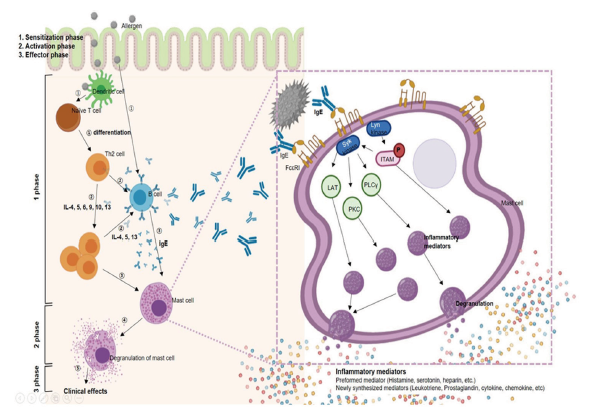
Fig. 1. An allergic reaction that occurs when pollens of weeds enter the human body. ① Allergens are delivered to T helper 2 (Th2) cells by dendritic cells (DCs) or directly stimulate B cells. ② Th2 cells secrete IL-4, 5, 6, 9, 10, and 13 to stimulate B cells or form Th2 complexes, and Th2 complexes also excessively secrete IL-4, 5, and 13 to stimulate B cells. ③ IgE secreted by the Th2 complex and stimulated B cells activates mast cells and induces degranulation of mast cells. IgE acts on the IgE high affinity receptor (FcεRI) on the surface of mast cells. When two or more FcεRIs are linked in a stable form by an allergen, Lyn kinase and Syk kinase are activated. Lyn kinase phosphorylates ITAM (immunoreceptor tyrosine-based activation motif) and acts on syk kinase or induces accumulation and degranulation of inflammatory substances in mast cells. In addition, Syk kinase also activates LAT, PKC, and PLCγ. to induce accumulation of inflammatory substances in mast cells and degranulation. ④ Inflammatory mediators accumulated in mast cells are secreted out of the cells through degranulation. ⑤ Th2, B cells, and mast cells are stimulated again by the secreted inflammatory mediators, causing a transient reaction and developing clinical symptoms
제3단계: 효과단계(effector phase)
여러 화학적 알레르기 매개물질로 인해 말초 혈관의 투과성 항진과 확장 작용, 점막 표면에 대한 점액질 분비 항진작용, 기관지 평활근의 수축작용 등이 발생하는 단계이다. 제1형 알레르기 반응에서 호산구를 비롯한 염증세포의 조직내 침윤에 의해 활성화된 염증 세포는 점막과 상피세포에서 면역반응이 과도하게 발생하여 만성적 코 막힘이나 비특이적 점막 과민성이 나타난다. 따라서 잠복기를 거친 후기 반응에서 비만세포에서 분비된 많은 염증 인자들에 의해 비염, 천식, 아토피피부염, 아나필락시스 등 임상증상 발현된다.
알레르기로 인한 동반 질환
알레르기 비염은 흔히 기관지천식, 알레르기 결막염, 부비동염, 중이염, 수면장애 등의 여러가지 질환들을 동반한다(Choi, 2013).
기관지천식
비염은 천식 발병의 중요한 인자이다(Kim and Jee, 2010). 일반적으로 천식의 유병율은 5% 정도이지만 비염환자의 10-40%에서 천식이 있고, 천식환자의 70-80%은 비염을 동반한다.
알레르기 결막염
알레르기 안질환은 주로 결막염으로 나타나는데 대부분은 증상이 경미한 계절성 혹은 통년성 알레르기 결막염이다(Hwang, 2017). 알레르기 결막염으로 결막이 공기 중의 알레르겐에 노출되었을 때 알레르겐이 결막의 IgE 항체와 결합하여 비만세포로부터 히스타민 등의 여러 가지 매체가 분비되어 발생한다.
아데노이드 비대증
아데노이드는 비인두에 위치하는 림프조직으로 편도와 함께 구강 및 비강을 통해 침입하는 병균이나 바이러스에 대해서 방어 작용을 하는 면역 기관이다.
아데노이드가 비대해지면 코막힘, 비음, 구강호흡, 코골이 등의 증상을 유발하며 심하면 항상 입으로 호흡해야 하기 때문에 얼굴의 발달 이상과 부정교합을 유발할 수 있다.
수면 장애
알레르기 비염환자에서 수면 장애는 흔한 증상이다. 알레르기 비염에 의한 코막힘은 수면 장애를 유발할 수 있는데, 코막힘이 전체 기도저항을 증가시키고 구강호흡을 유발하기 때문에 분당 환기량의 감소를 일으켜 이산화탄소 배출에 영향을 미치는 등의 기전으로 수면호흡 장애를 일으킨다.
만성 기침
8주 이상 지속되는 기침을 만성기침이라고 한다. 상기도 기침 증후군은 만성기침의 가장 흔한 원인으로 이는 기저질환과 상관없이 비강이나 부비동의 자극때문에 일어난다.
알레르기 유발 잡초
잡초 중에서 알레르기를 일으키는 것으로 알려져 있는 식물의 특성에 대해서 소개한다. 우리나라에서 식물 알레르기에 관한 연구는 한양대학교 구리병원 오재원 교수 연구진에 의해 주로 이루어졌으며(Choi et al., 2020; Oh, 2009; Oh et al., 2006; 2015), 본 리뷰에서 소개하는 알레르기 유발 식물목록은 오재원 교수의 논문과 출판도서에서 선정하였고, 잡초성 식물에 대한 결정은 한국잡초학회 회원이신 오세문 박사가 출판한 한국잡초명집(Oh, 2003)에 따랐다(Table 1). 식물 알레르기는 모두 꽃가루에 의해 발생하기 때문에 식물 특성은 주로 화서에 국한하여 설명하였다.
Table 1. Allergy producing weeds and their flowering periods in Korea.
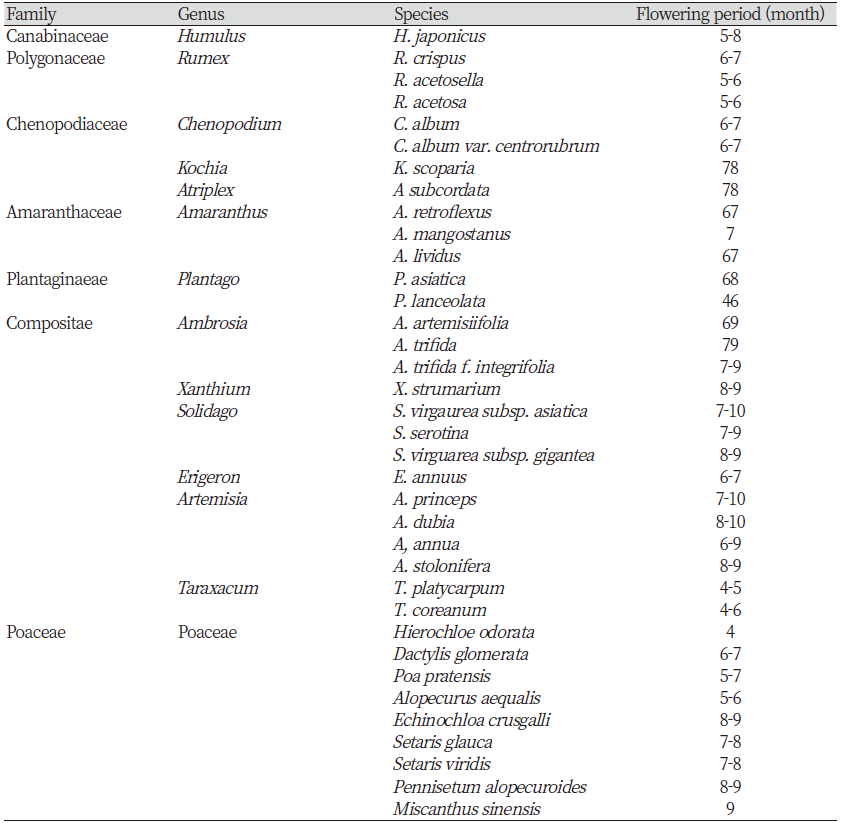
|
|
Data were obtained from papers of Choi et al. (2020), Oh (2008), and Oh et al. (2006; 2015). |
환삼덩굴속(Humulus)
환삼덩굴속은 북반구에 2-3종이 분포하고 있는 덩굴성 초본이며, 우리나라 전역의 수로와 강변에서 많이 발생하여 생태계를 파괴하는 외래 잡초이며(Oh et al., 2002), 광범위한 지역으로 확산되고 있어서(Fig. 2) 가을철 주요한 꽃가루 알레르기 원인이 되는 잡초이다.
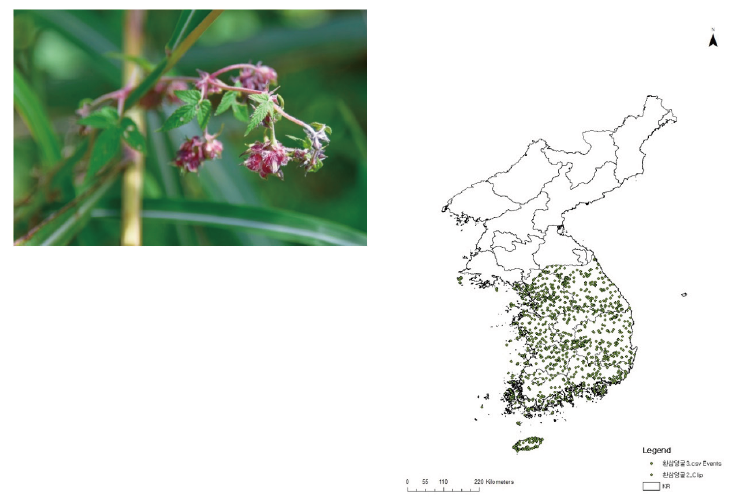
Fig. 2. Humulus japonica plant and the distribution map in Korea. This plant is a noxious weed in mountainous areas, farmland and near farmhouses. Weed location dots on the right figure were prepared using ArcGIS (desktop version 10.8) based on the National Habitat Survey (NIE, 2016) by the National Institute of Ecology and field survey information of authors.
꽃은 암수딴그루로 피며 수꽃 이삭은 원추화서로 잎겨드랑이에 달리고 개화기는 5-8월이다. 국내에서 발견된 환삼덩굴속 식물로는 환삼덩굴(Humulus japonica Sieboldi et Zuccarini; Fig. 2)과 홉(Humulus lulus L.)이 있다. 홉은 1970년대까지만 해도 우리나라 일부 고랭지역에서 재배가 이루어졌지만 지금은 재배가 이루어지고 있지 않으며, 자연생태계에서는 거의 발견되지 않기에 환삼덩굴속 식물의 알레르기는 주로 환삼덩굴에 의한 것이라고 추론된다(Park et al., 1998).
공기 중에 환삼덩굴 꽃가루가 몇 개가 있으면 사람들이 알레르기 증상을 보일까? Choi et al. (2020)은 서울 수도권에서 매일 8년간 꽃가루를 수집한 다음, 꽃가루 농도와 알레르기 증상지수간의 관계를 분석하여 위험지수를 결정하였는데, 저자들은 환삼덩굴의 꽃가루가 9-10 ea m-3 경우의 위험지수는 보통, 11-19 ea m-3 경우에는 심각, 20 ea m-3 경우에는 위험이라 결정하였다.
환삼덩굴 꽃가루에 노출된 환자들의 임상적 특징으로는 천식, 알레르기성 비염, 결막염을 들 수 있다(Park et al., 1998).
소리쟁이속(Rumex)
소리쟁이속은 마디풀과에 속하며 전세계적으로 약 200여 종이 발견되며, 우리나라에는 12종이 서식하고 있다. 소리쟁이속은 일년생 또는 다년생식물로 꽃은 양성화 혹은 단성화이다. 꽃자루가 마디에 돌려 달리며, 많은 화분을 바람에 날려보내는 풍매화이기도 하지만 곤충에 의해 수분이 일어나는 충매화이기도 하다(Lee, 2003; 2006).

Fig. 3. Rumex crispus plant and the distribution map in Korea. This allergic plant is a noxious weed in wetlands, cropland and pastures. Weed location dots on the right figure were prepared using ArcGIS (desktop version 10.8) based on the National Habitat Survey (NIE, 2016) by the National Institute of Ecology and field survey information of authors.
소리쟁이(Rumex crispus)
소리쟁이(Fig. 3)는 마디풀과의 다년생식물로 키가 50-100 cm까지 자라며 전국의 습지, 농경지, 목초지 등에서 주로 발견되는 외래 잡초이며 전국적으로 분포하고 있다(Kim et al., 2010; Park, 2009). 붉은색의 꽃은 윤생하며 원추화서로 6월~7월에 피며, 풍매화 혹은 충매화이기도 하다(Lee, 2003; 2006). 참소리쟁이(Rumex japonicus)에 비해 잎 가장자리에 주름이 많고 열매의 내화피가 원형이며 톱니가 없는 것이 특징이다. 소리쟁이의 꽃가루 크기는 25-30 μm이다(Oh et al., 2015).
우리나라에서 소리쟁이는 전국 목초지에서 많이 발견이 되는데 인구밀집지역 인근에도 목초지가 있는 만큼(Lee et al., 2017b), 소리쟁이를 방제하지 않고 방치한다면 향후 꽃가루로 인한 알레르기는 지속적으로 국민 건강에 위협이 될 것이라 예상된다.
애기수영(Rumex acetosella)
애기수영(Fig. 4)은 키가 20-50 cm까지 자라는 다년생 식물로 우리나라 전역의 양지바른 곳과 목초지에서 다수 발생하는 것으로 보고된 외래 잡초이다(Kim et al., 1999; Park, 2009). 꽃은 암수딴그루이고, 원줄기 끝에 홍록색의 꽃이 5-6월 사이에 원추화서로 달린다. 애기수영의 개화기인 5-6월에는 태백산맥 서쪽으로부터 동쪽으로 편서풍이 불어서 양간지풍이 발생하는데 이로 인해서 산불이 심하게 발생한다. 바람이 꽃가루를 날려 알레르기 비염의 발생에 영향을 미친다는 연구보고(Kim et al., 2015b)는 강원도 고냉지대에 대단위로 조성된 목초지에 다수 발생하는 것으로 알려진 애기수영(Kim et al., 1999)의 꽃가루가 쉽게 양간지풍을 따라 동해안 지역으로 이동하여 주민들에게 알레르기를 일으킬 가능성이 높을 것이라 추론된다. 편서풍이 부는 시기에 영서지역과 영동지역의 애기수영 화분 밀도와 주민을 대상으로 알레르기 발생 빈도를 조사하면 바람이 애기수영 화분의 이동에 미치는 영향에 대해 이해할 수 있을 것이다.
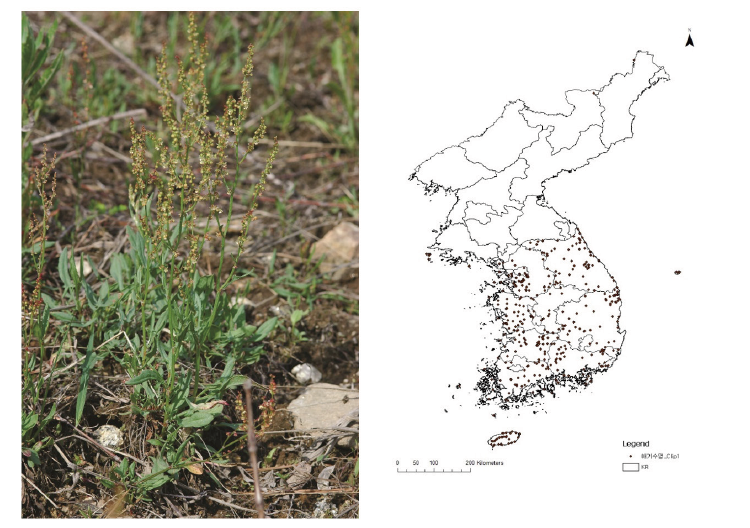
Fig. 4. Rumex crispus plant and the distribution map in Korea. This allergic plant is a noxious weed in wetlands, cropland and pastures. Weed location dots on the right figure were prepared using ArcGIS (desktop version 10.8) based on the National Habitat Survey (NIE, 2016) by the National Institute of Ecology and field survey information of authors.
수영(Rumex acetosa)
수영(Fig. 5)은 전국에서 발견되는 다년생 식물로 키는 30-80 cm까지 자라고, 땅속줄기가 크게 자라는 잡초이다. 연녹색 또는 녹자색의 꽃은 암수딴그루로 애기수영과 마찬가지로 5월부터 6월 사이에 윤생하면서 피며 원추화서를 이룬다.
소리쟁이속에는 수영, 애기수영, 묵발소리쟁이, 호대화, 소리쟁이, 개대황, 금소리쟁이, 돌소리쟁이가 우리나라에서 서식한다(Lee, 2003; 2006). 모든 소리쟁이속 잡초 화분이 알레르기를 일으키는 것은 아니지만 수영, 애기수영과 소리쟁이가 알레르기를 일으키는 것으로 보고되었기에 면밀한 연구를 통해 국민 건강에 악영향이 일어나지 않도록 잡초방제에 만전을 기해야 할 것이다.

Fig. 5. Rumex acetosa plant and the distribution map in Korea. This allergic weed flowers in May and June. Weed location dots on the right figure were prepared using ArcGIS (desktop version 10.8) based on the National Habitat Survey (NIE, 2016) by the National Institute of Ecology and field survey information of authors.
명아주속(Chenopodium)
명아주속은 명아주과(Chenopodiaceae)에 속하는 일년생 혹은 다년생 식물로 전세계적으로 약 170여종이 발견되었고, 우리나라에는 9종이 있는데 대표적인 종류로는 명아주(Chenopodium album L.), 창명아주(C. bryoniaefolium Bunge), 좀명아주(C. ficifolium Smith), 취명아주(C. glaucum L.)를 들 수 있다(Lee, 2003; 2006). 명아주속 식물 중 밭 경작지에서 발견되는 대표적인 잡초인 명아주가 알레르기를 일으키는 것으로 보고되었는데(Oh, 2007), 꽃은 양성화로 잎 겨드랑이에서 이삭화서 또는 원추화서로 달린다.
명아주과는 쑥과, 두드러기쑥과 다음으로 많은 화분을 날리며, 가을철 화분증을 유발하는 주요 식물이다. 화분의 모양은 골프공 모양이며, 크기는 20-30 μm 정도이고(Chung and Lee, 1995), 비름속의 화분과 형태가 유사하여 구분이 쉽지 않다(Oh, 2007).
명아주(Chenopodium album L.)
명아주는 유라시아 원산의 귀화식물로 어린 잎에 붉은 분이 도는 붉은 능쟁이라 불리는 원변종이 있고, 이와는 구분되는 명아주(C. album var centrorubrum Makino)가 환경에 따른 생태형이라 판단되어 지금은 흰명아주로 통합되었기에(Chung, 2001), 흰명아주에 대한 자료는 모두 명아주로 분류되기도 한다. 명아주는 일년생 식물로 높이 1 m까지 자라며 가지 끝에 수상화서가 발달하여 전체적으로 원추화서를 형성하는 우리나라 전국의 밭과 초지에서 주로 발견된다(Lee et al. 2017a; Fig. 6). 꽃은 황록색으로 양성화이며 개화기는 6월부터 7월 사이이다. 명아주 화분의 형태학적 특징에 대해서는 건초열(hay fever)을 일으키는 주범으로 알려져 있고 전세계의 건조 혹은 반건조지역에서 알레르기를 일으키는 최고의 주범이기에(Barderas et al., 2002) 공중보건 측면에서도 많은 연구가 이루어져서 비교적 많은 자료가 축적되어 있다(Kmenta et al., 2014; Nouri et al. 2013; Turkeltaub et al., 2019). 명아주 화분 형태는 구형이며, 직경은 평균 26.7 μm 정도이고, 화분 표면에 나 있는 공구 수는 평균 118개이다(Chung and Lee, 1995).
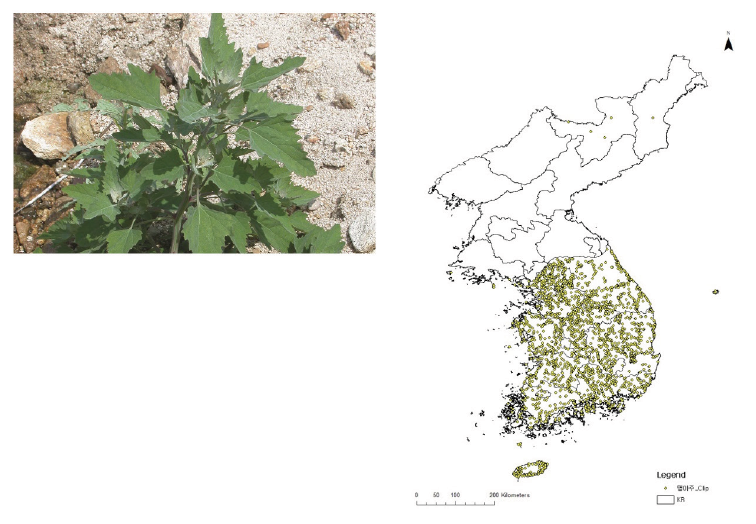
Fig. 6. Chenopodium album plant and the distribution map in Korea. This allergic weed is mainly found in agricultural fields and pastures. Weed location dots on the right figure were prepared using ArcGIS (desktop version 10.8) based on the National Habitat Survey (NIE, 2016) by the National Institute of Ecology and field survey information of authors.
댑싸리속(Kochia)
댑싸리속은 명아주과에 속하는 식물로 유럽, 아시아, 오스트레일리아, 아프리카에 약 80종, 우리나라에는 댑싸리(Kochia scoparia Schrader)와 갯댑싸리(Kochia scoparia Schrader var. littorea Makino)가 서식하고 있다(Lee, 2003; 2006).
댑싸리(Kochia scoparia Schrader)
댑싸리는 중국 원산의 1년생 외래식물로 줄기와 가지는 곧게 서서 키는 1-1.5 m 높이까지 자라며 우리나라에서는 그리 많이 발생하지는 않는다(Fig. 7). 꽃은 7-8월에 연녹색 혹은 붉은색으로 피는데 양성화이다. 댑싸리는 조기에 발아하고(Schwinghamer and Van Acker, 2008), 종자생산이 많으며, 스트레스에 저항하는 힘이 커서 북미에서는 농경지, 일반 나지, 가축 방목지에서 자라는 10대 악성 잡초이다(Friesen et al., 2009). 댑싸리의 꽃가루는 구형이고 직경은 20-40 μm이며, 화분의 표면에 나 있는 공구 수는 100-130개이다(Stalings et al., 1995). 댑싸리 성체는 많은 양의 화분을 생산하는데(Mulugeta, 1991), 바람이 중요한 교차수분의 매개체인 풍매화이지만 꿀벌에 의해 매개되기도 하는 충매화이기도 하다(Blackwell and Powell, 1981).
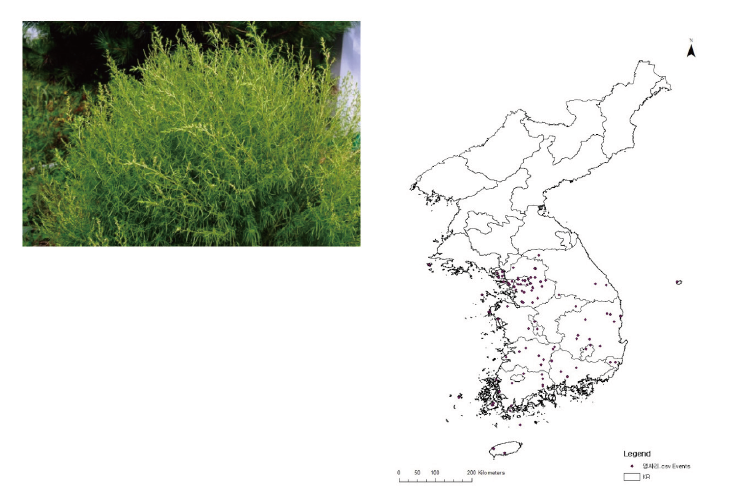
Fig. 7. Kochia scoparia plant and the distribution map in Korea. This allergic weed has high seed production and strong ability to resist stress. This noxious weed grows well in farmlands and livestock pastures. Weed location dots on the right figure were prepared using ArcGIS (desktop version 10.8) based on the National Habitat Survey (NIE, 2016) by the National Institute of Ecology and field survey information of authors.
갯는쟁이속(Atriplex)
갯능쟁이속은 명아주과에 속하며 전 세계적으로 100종 이상이 발견되지만, 우리나라에는 2종이 분포한다. 꽃은 모여 붙어 피며 이삭화서가 모여 원추화서를 이룬다(Lee, 2003; 2006). 갯능쟁이속의 식물은 알레르기를 일으키는 것으로 보고되었다.
갯능쟁이(Atriplex subcordata Kitagawa)
갯능쟁이는 해변에서 나는 일년생 염생식물(Fig. 8)로 키는 40-60 cm에 달하며 꽃은 단성화로 연녹색이다. 7월부터 8월사이에 줄기 끝이나 잎겨드랑이에 다수의 꽃이 모여 달려 이삭화서를 이룬다(Lee, 2006).
비름속(Amaranthus)
비름속은 비름과(Amaranthaceae)에 속하는 식물로 세계에는 약 50종이 분포하고 있다(Gadermaier et al., 2014). 우리나라에는 눈비름(Amarnthus deflexus L.), 개비름(A. lividus L.), 비름(A. smangostanus L.), 털비름(A. retroflexus L.), 가시비름(A. spinosus L.), 색비름(A. tricolor L.), 청비름(A. viridis L.) 등이 귀화하여 서식하고 있는데(Lee et al., 2017a; Park, 2009), 비름속 식물들은 교차 알레르기 반응을 보인다고 보고되어 있다(Hong, 2015). 꽃은 소형으로 녹색, 흰색 또는 붉은색이며 잎 겨드랑이에 모여 달리거나 줄기 끝에 이삭화서나 원추화서를 형성한다(Lee, 2006). 비름속 식물 중 털비름, 비름, 개비름이 알레르기를 일으키는 것으로 보고되었다. 또한 많은 나라에서 A. hybridus, A. spinosus, A. viridis는 알레르기를 일으키는 단백질을 방출한다고 보고되었다(Siriwattanakul et al., 2014). 비름속 꽃가루는 전자현미경으로보면 명아주 꽃가루와 크기와 모양이 비슷하며 털비름의 크기는 28-29 μm, 개비름의 크기는 22-24 μm로 발아구는 두 종 모두 다공형이다(Oh et al., 2015).
털비름(Amaranthus retroplexus)
알레르기를 유발하는 잡초인 털비름은(Gardermaier et al., 2014) 열대 아메리카가 원산으로 우리나라에서는 중부지방에서 드물게 발견된다(Park, 2009). 밭이나 길가에서 자라는 일년생 잡초이다(Fig. 9). 키는 30-80 cm에 달하며 꽃은 양성화로 녹색이며 줄기의 끝이나 잎겨드랑이에 모여 달리는 이삭화서가 원기둥 모양을 이룬다. 개화는 6-7월이다(Lee, 2006).

Fig. 9. Amaranthus retroplexus plant and the distribution map in Korea. This annual allergic weed is found in fields and along roadsides. Weed location dots on the right figure were prepared using ArcGIS (desktop version 10.8) based on the National Habitat Survey (NIE, 2016) by the National Institute of Ecology and field survey information of authors.
비름(Amaranthus mangostatus)
알레르기를 유발하는 잡초인 비름은(Siriwattanakul et al., 2014), 인도 원산의 일년생 잡초이며 키는 1-1.2 m이고(Fig. 10), 꽃은 녹색으로 7월에 줄기 끝이나 잎겨드랑이에 모여 달리는 이삭화서가 원추형을 이룬다(Lee, 2006).
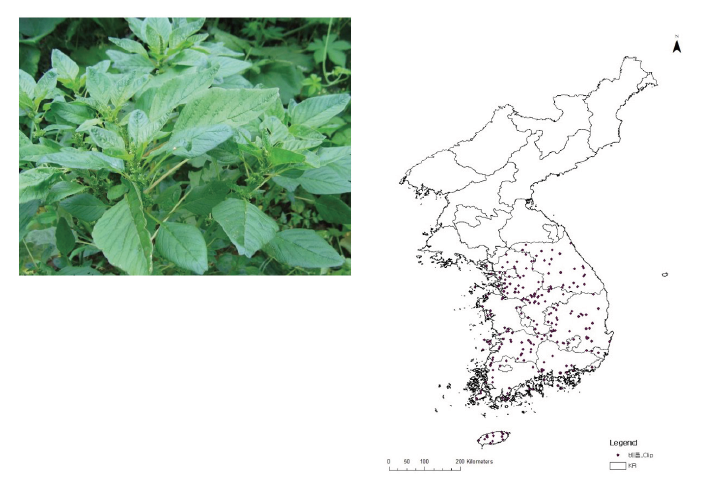
Fig. 10. Amaranthus mangostatus plant and the distribution map in Korea. This allergic annual weed is native to India. Weed location dots on the right figure were prepared using ArcGIS (desktop version 10.8) based on the National Habitat Survey (NIE, 2016) by the National Institute of Ecology and field survey information of authors.
개비름(Amaranthus lividus)
알레르기를 유발하는 잡초인 개비름은(Siriwattanakul et al., 2014), 유럽 원산이며(Park, 2009) 우리나라에서는 전국적으로 밭이나 민가 근처에 자란다(Fig. 11). 초장은 30-80 cm인 일년생 잡초이다. 꽃은 녹색으로 양성화이며 줄기 끝이나 잎겨드랑이에 모여 달리는 이삭화서가 원기둥 모양을 이룬다. 개화기는 6-7월이다(Lee, 2006).
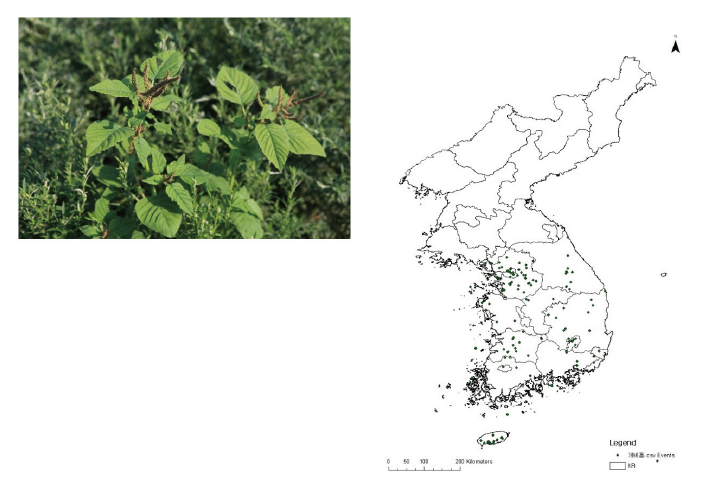
Fig. 11. Amaranthus lividus plant and the distribution map in Korea. This plant is native to Europe, and this exotic allergic weed grows well in fields and near farmhouses. Weed location dots on the right figure were prepared using ArcGIS (desktop version 10.8) based on the National Habitat Survey (NIE, 2016) by the National Institute of Ecology and field survey information of authors.
질경이(Plantago asiatica)
질경이속(Plantago depressa)
질경이속에는 전세계에 약 200여 종이 발견되고 있는데 우리나라에는 질경이(Plantago asiatica), 개질경이(Plantago camtschatica Cham. ex Link), 털질경이(Plantago depressa depressa Willd.), 창질경이(P. lanceolata), 왕질경이(P. major var japonica) 5종이 발견된다(Lee, 2006). 꽃은 양성화이고 간혹 잡성화 혹은 단성화이다.
질경이는 우리나라의 들이나 길가에서 다발생하는 일년생 잡초이다(Fig. 12). 꽃은 흰색이고 꽃줄기는 길이 10-15 cm이며, 꽃줄기 끝에 많은 이삭화서를 이루는데, 화관은 깔때기 모양이고 수술은 길고 화관 밖으로 나온다(Sano et al., 2016). 개화기는 6-8월이다(Lee, 2006). 질경이의 꽃가루 크기는 23-28 μm으로 발아구는 공형이다(Oh et al., 2015).

Fig. 12. Plantago asiatica plant. This allergic plant is a common weed grows on the roadside. Weed location dots on the right figure were prepared using ArcGIS (desktop version 10.8) based on the National Habitat Survey (NIE, 2016) by the National Institute of Ecology and field survey information of authors.
창질경이(Plantago lanceolata)
창질경이는 유럽 원산으로 우리나라에서는 해안지역의 들이나 길가에서 흔히 자라는 다년생 외래잡초이다(Lee, 2006; Park 2009; Fig. 13). 우리나라에는 남부지방에서 주로 발견되는데 서울, 인천, 백령도 등 중부지방에도 간혹 발견된다(Park, 2009). 꽃은 흰색으로 이삭화서, 꽃줄기는 길이 50 cm 가량이고 개화는 4-6월에 이루어진다(Lee, 2006). 그러나 꽃은 8월까지 피는 것으로도 보고되어 있으며(Lee, 2003), 꽃자루는 30-60 cm로서 끝에 수상화서가 달리고 꽃차례는 처음에는 둥글지만 자라면서 수상화서가 된다. 꽃부리는 백색이지만 자주색 꽃밥이 더욱 뚜렷하다 창질경이는 알레르기성이 높은 식물로 알려져 있으며(Gardermaier, 2014), 화분은 6-7월사이에 공기 중에 날라 다니며, 모양은 구형으로 여러 개의 홈이 있고 꽃가루 크기는 23-25 μm이며 발아구는 다공형이다. 창질경이는 질경이 속 식물 중 알레르기 항원성이 가장 강하다(Oh, 2007; Oh et al., 2015).
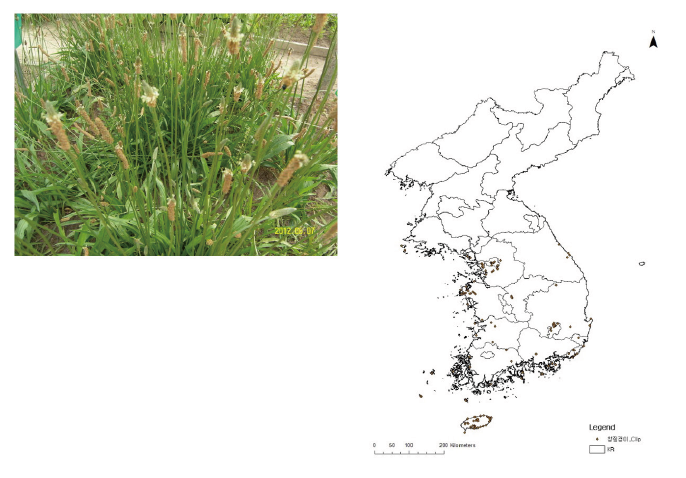
Fig. 13. Plantago lanceolata plant and the distribution map in Korea. This allergic plant is native to Europe and is a common weed grows on the field and roadside. Weed location dots on the right figure were prepared using ArcGIS (desktop version 10.8) based on the National Habitat Survey (NIE, 2016) by the National Institute of Ecology and field survey information of authors.
돼지풀속(Ambrosia)
돼지풀속은 국화과(Compositae)에 속하는 식물로 아메리카와 지중해 부근에 약 20종이 분포하며 알레르기를 일으키는 대표적인 잡초이다. 우리나라에는 2종이 귀화해서 서식하고 있으며 꽃은 단성화이고, 두상화서를 가진다.
돼지풀(Ambrosia artemisiifolia L. var. elatior Descourtils)
북아메리카가 원산인 일년생의 외래잡초이며(Park et al., 2017), 전국의 밭, 목초지, 과수원에서 발견되는 외래 잡초이다(Lee et al., 2017a; Fig. 14). 초장은 50-100 cm 정도이고, 꽃은 단성화이다. 수꽃의 두상화서는 가지 끝에 이삭 모양으로 달리고, 암꽃의 두상화서는 수꽃 화서 밑의 겨드랑이에 붙으며, 모두 관성화로 된다(Lee, 2006). 꽃은 6-9월에 피며 자웅동주이다. 불임성 두화는 웅성이며 10-15개의 황색 통상화를 이루어지는데 총상화서를 만든다(Park, 2009). 돼지풀 한 개체는 하루에 약 100만개의 꽃가루를 공기 중으로 날려보내서 꽃가루 알레르기를 일으키는데 꽃가루 크기는 20-22 μm로 발아구는 공형과 구형이 같이 있는 공구형으로 꽃가루 표면에는 작은 비닐모양의 돌기들이 있으며(Oh et al., 2015) 가을철 강한 알레르기 항원성을 보이는 대표적인 알레르기 유발 잡초이다(Oh, 2007; Oh et al., 2000). 돼지풀은 단풍잎돼지풀에 비해 식물체가 작고 줄기 위쪽의 잎은 점차 작아진다.
단풍잎돼지풀(Ambraosia trifida L.)
단풍잎돼지풀은 북아메리카 원산의 일년생 식물이며 우리나라에서는 중북부지역에서 다발생하고 있다(Fig. 15). 돼지풀에 비해 식물체가 크고, 홑잎이며 깊게 3-5 갈래로 갈라진다. 일명 세잎돼지풀로도 알려져 있다(Lee, 2006). 단풍잎돼지풀 중에서 잎이 타원형 또는 장타원형이고 분열되지 않으면서 잎 가장자리에 톱니가 있는 변종인 둥근잎돼지풀(Ambraosia trifida L. var. integrifolia [Muhl] Fern.)이 서울과 강원 춘천에서 발견된다(Park, 2009). 단풍잎돼지풀은 7-9월에 꽃이 피는데 불임성 두화로 이루어진 총상화서는 길이 8-25 cm이다. 우리나라에는 중부지방에 분포하며 최근에는 남부지방의 밭, 과수원, 목초지까지 확산되고 있으며(Kim et al., 2018; Lee et al., 2017a), 넓은 엽면적, 다수의 종자생산, 높은 종자발아율, 알렐로파시 물질의 배출을 통한 자생식물의 생장 억제 효과 때문에 생태계교란 식물로 지정되었다(Choi et al., 2007; 2010; Kong et al., 2007). Jang et al. (2011)은 8월부터 10월사이에 우리나라에서 잡초류 중 환삼덩굴과 단풍잎돼지풀의 꽃가루 농도가 특히 높았는데 단풍잎돼지풀의 대기 중 꽃가루 농도와 알레르기 증상 간에는 상관관계가 높았다고 보고하였다. 꽃가루를 날려 알레르기를 일으켜 국민건강에 악영향을 미치는 잡초에 대한 체계적인 연구가 필요하다. 단풍잎돼지풀 꽃가루가 알레르기를 일으킨다면 유전적으로 유사한 돼지풀, 둥근잎돼지풀 꽃가루에 대한 면밀한 교차 면역반응 뿐만 아니라, 국화과 식물과의 교차 면역반응 역시 매우 시급한 연구가 될 것이다. 뿐만 아니라 단풍잎돼지풀처럼 알레르기를 일으키는 것으로 알려져 있는 외래 잡초에 대한 예방 차원에서의 수입금지와 이미 도입되어 알레르기를 일으키는 잡초류에 대한 방제가 국가적으로 이루어져야 할 것이다.
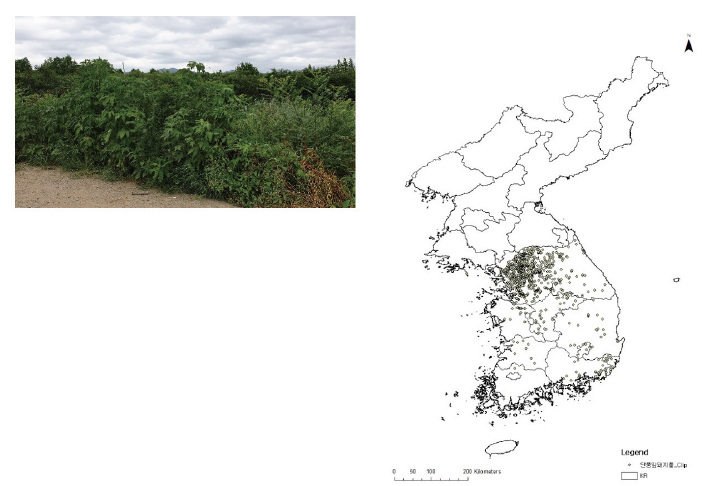
Fig. 15. Ambrosia trifida plant and the distribution map in Korea. This allergic plant is native to North America and is a common noxious weed with characteristics of large leaf area, large number of seed production, high seed germination rate, and allelopathic chemicals emission. This plant was found in northern Gyeonggi and Gangwon in 70s, now found in all over Korea and disrupting ecosystem. Weed location dots on the right figure were prepared using ArcGIS (desktop version 10.8) based on the National Habitat Survey (NIE, 2016) by the National Institute of Ecology and field survey information of authors.
도꼬마리속(Xanthium)
도꼬마리속은 전세계에 약 25종이 발견되는데 우리나라에는 도꼬마리(Xanthium strumarium L.), 큰도꼬마리(X. canadense Mill.), 가시도꼬마리(X. italicum Moore) 3 종이 자생하고 있다(Hong, 2015; Park, 2009). 꽃은 풍매화로 두상화서를 이루며 피는데, 수꽃의 두상화서는 가지 끝에 밀생하여 둥근 모양이다(Lee, 2006). 많은 양의 꽃가루를 생산하기도 하지만 대부분 중간 정도 양의 꽃가루를 생산하기 때문에 꽃가루병의 원인으로 크게 주목받지는 못하고 있지만 강한 알레르기성을 가지고 있다. 미국 캘리포니아 지역의 알레르기 환자에서 도꼬마리 꽃가루에 대한 알레르기 피부시험 양성률이 24.1%라 보고된 바 있다(Galant et al., 1998).
도꼬마리(Xanthium strumarium L.)
도꼬마리는 아시아 대륙이 원산이며 국내에는 오랜 옛날에 귀화하였고 전국의 들과 길가 그리고 밭과 과수원에서 발견되는 일년생 잡초이다(Lee et al., 2017a; Park, 2009; Fig. 16). 꽃은 노란색이고, 단성화이며, 자웅동주이고 가지와 줄기 끝에 원추화서를 이룬다. 수꽃의 두상화서는 다소 둥근 모양이고 가지 끝에 달린다. 개화기는 8-9월이다(Lee, 2006). 큰도꼬마리(X. canadens Mill.)에 비해 총포가 작고 보다 작은 가시가 엉성하게 부착된다(Park, 2009)

Fig. 16. Xanthium strumarium plant and the distribution map in Korea. This allergic plant is native to Asia and annual weed found in the field, roadside and orchard. Weed location dots on the right figure were prepared using ArcGIS (desktop version 10.8) based on the National Habitat Survey (NIE, 2016) by the National Institute of Ecology and field survey information of authors.
미역취속(Solidago)
국화과의 미역취속에는 전 세계적으로 약 190종이 존재하는데(Fursenco et al., 2020), 우리나라에는 미국미역취, 미역취, 을릉미역취가 서식하고 있다. 미역취속 식물은 모두 다년생 식물로 꽃은 이삭모양 또는 원추형으로 늘어서는 특징이 있다(Lee, 2003; 2006).
미역취(Solidago virgaurea L. var. asiatica Nakai)
미역취는 돼지나물이라고도 불리우며 산, 들과 목초지에서 발견되는 잡초이다(Lee et al., 2017a; Fig. 17). 꽃은 노란색으로 3-5개의 두상화서가 산방상의 이삭화서를 이룬다. 꽃은 7-10월에 피며, 결실은 10-11월에 이루어진다(Lee, 2003; 2006). 미역취의 꽃가루는 알레르기를 일으키는 단백질이 함유되어 있으며(Bains et al., 2008), 미역취 꽃가루 추출물 역시 알레르기를 일으킨다고 보고되었다(de Jong et al., 1998).
미국미역취(Solidago serotina Aiton)
미국미역취는 북아메리카 원산의 다년생 식물로 주로 과수원에서 발견되는 잡초이다(Lee et al., 2017a). 키는 1 m 이상 되어 미역취속 중에서는 가장 크다. 줄기는 윗부분에서 가지가 갈라지며, 꽃은 노란색으로 두상화서가 줄기나 가지 끝에 총상으로 밀생한다. 꽃은 7-9월에 핀다(Lee, 2003; 2006).
울릉미역취(Solidago virgaurea L. ssp. gigantea [Nak.] Kitamura)
울릉미역취는 나래미역취라고 불리는데 15-75 cm에 달하는 다년생 식물이다. 노란색의 꽃이 잎 겨드랑이에서 원추상으로 나서 두상화서를 8-9월에 형성한다(Lee, 2003; 2006). 미역취와 다른 점은 두화가 밀착해서 나는 것을 들 수 있다.
개망초속(Erigeron)
국화과(Compositae)의 망초속 식물은 전 세계적으로 약 250여종이 발견되었으며 대부분 일년생 또는 이년생이다. 두상화서에는 설상화가 있는 것과 없는 것이 있으며, 설상화는 암꽃, 관상화는 양성화이고 농경지에 서식하는 개망초속 식물들은 작물과 빛, 물, 양분을 놓고 경쟁을 하는 잡초의 특성을 보인다(Hubregtse, 2020; Kim et al., 2014; Kim et al., 2015a; Weaver, 2001).
개망초(Erigeron annuus [L.] Persoon)
개망초는 북아메리카가 원산으로 우리나라 전역의 밭, 목초지, 과수원, 길가에서 다발생하는 월년생 잡초이다(Lee et al., 2017a; Park, 2009; Fig. 18). 근생엽은 꽃이 필 때 시드는데 두상화는 흰색이고 가지와 줄기 끝에 산방상으로 달린다. 자주빛을 띈 설상화가 2-3줄 있다. 개화기는 6-7월이다(Lee, 2003; 2006).

Fig. 18. Erigeron annuus plant. This plant is native to North America and found in fields, pastures, orchards, and along roadsides. Weed location dots on the right figure were prepared using ArcGIS (desktop version 10.8) based on the National Habitat Survey (NIE, 2016) by the National Institute of Ecology and field survey information of authors.
쑥갓속(Chrysanthemun)
쑥갓속은 국화과에 속한다. 국화과는 북반구 및 아프리카의 북부와 남부에 약 200종이 발견된다. 두상화서는 가지 끝에 1개 또는 여러 개가 산방상을 이룬다. 개화기는 9-10월이다(Lee, 2003; 2006).
감국(Chrysanthemum indicum L.)
감국은 들국화로도 불리우고 우리나라에서는 주로 산지의 밭에서 자라는 다년생 잡초이다(Fig. 19). 초장은 30-60 cm 정도이고 깃 모양으로 재배 국화보다 더 갈라지고 결각 모양의 톱니가 있다. 두상화는 노란색이고, 지름 2-2.5 cm의 두상화서가 줄기 끝에 산방상으로 달린다. 두상화서 가장자리 1줄은 설상화이고, 가운데는 관상화이다. 개화기는 9-11월이다(Lee, 2003; 2006).

Fig. 19. Chrysanthemun indicum plant and the distribution map in Korea. This weed is found in the field of mountainous area. This weed causes allergy by releasing pollen from September and November. Weed location dots on the right figure were prepared using ArcGIS (desktop version 10.8) based on the National Habitat Survey (NIE, 2016) by the National Institute of Ecology and field survey information of authors.
쑥속(Artemisia)
쑥속은 국화과(Asteraceae)에 속하며 북반구에는 약 250종이 발견되며 우리나라에도 약 25종이 분포하고 있다. 반관목 또는 다년생 식물이며 두상화서는 작고, 다수이다. 총상 또는 원추형을 이루며, 암술과 수술은 동시에 또는 시기를 달리해서 성숙한다. 두상화서 가장자리에는 암꽃이 달리고, 가운데는 양성화로 방사상통형을 이룬다(Lee, 2003; 2006).
쑥(Artemisia princeps)
쑥은 약쑥 또는 사재발쑥으로도 불리며, 우리나라 전역의 들에서 주로 발견되는 다년생 잡초이다(Fig. 20). 초장은 60-120 cm 정도이고 전체에 거미줄 같은 흰 털이 밀생한다. 두상화는 연한 홍자색이고 난형이며 지름은 1.5-3 mm 정도이다. 두상화서가 원추화서 모양으로 줄기 끝에 한 쪽으로 치우쳐 달린다. 개화기는 7-10월이다(Lee, 2006). 쑥은 토종식물로 강한 알레르기를 보이는 대표적인 잡초이다. 쑥의 꽃가루는 21-24 μm로 발아구는 공구형이다. 국내외에 사용되는 쑥 알레르기 피부 시험 시약은 대개 쑥(mugwort)으로 만들어지는데 이는 쑥속 식물 간의 교차 알레르기 반응이 있어 한 종만 시약으로 이용한다(Oh et al., 2015). 동속 식물 간에 교차 알레르기 반응이 보고된다는 점은 동속의 식물들은 알레르기를 일으킨다고 추론된다.
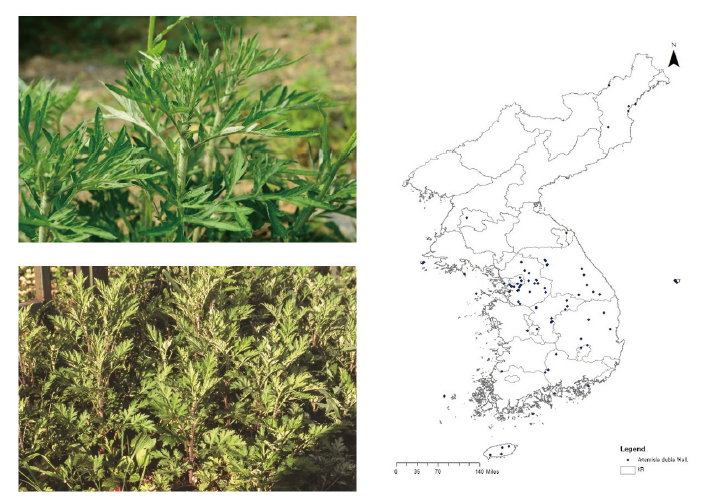
Fig. 20. Artemisia princeps plant and the distribution map in Korea. This perennial weed grows in the field and has a long history of medicinal use. Weed location dots on the right figure were prepared using ArcGIS (desktop version 10.8) based on the National Habitat Survey (NIE, 2016) by the National Institute of Ecology and field survey information of authors.
참쑥(Artemisia lavandulaefolia De Candolle)
주로 들에 나는 다년생 잡초로 초장은 15-20 cm 정도이다. 두상화는 연한 붉은색이고 지름은 3 mm 정도 되며 둥근 종 모양이다. 참쑥의 화서는 좁은 원추화서 모양으로 잎과 함께 달리며 개화기는 8-10월이다(Lee, 2003; 2006).
개똥쑥은 황무지, 강가, 밭이나 과수원에서 발견되는 일년생 잡초이며(Lee et al., 2017a; Fig. 21), 초장은 1 m가량이다. 두상화는 소형으로 녹황색이고 지름은 1.5 cm 정도이다. 암꽃의 관상화와 양성화의 관상화가 모양이 서로 다르고, 암술과 수술의 성숙시기는 다르며 개화는 6-9월에 이루어진다(Lee, 2003; 2006).
개똥쑥은 전 세계의 북반구 특히 유럽과 아시아에 약 250종이 서식하고 있으며 알레르기를 일으킨다고 보고되었다. 개똥쑥은 중국에서도 알레르기를 일으키는 주요한 식물인데, 꽃가루는 Th2를 감소시키고, Tr1과 nTreg는 증가시키며 코에서 cystatin 1을 증가시킨다(Lou et al., 2020).

Fig. 21. Artemisia annua plant and the distribution map in Korea. This allergic plant is an annual weed that is commonly grown in wasteland, riverside, fields, and orchards. Weed location dots on the right figure were prepared using ArcGIS (desktop version 10.8) based on the National Habitat Survey (NIE, 2016) by the National Institute of Ecology and field survey information of authors.
화본과(Poaceae)
화본과는 전세계적으로 550속 10,000여 종이 발견된다. 우리나라에는 80속 약 187종이 분포하고 있는데 피자식물 중에서는 가장 큰 과의 하나이다. 꽃은 대개 줄기 끝에 이삭화서, 원추화서, 총상화서 모양으로 달리며 꽃은 양성화 또는 단성화이고 암술, 수술, 인피, 외영, 내영으로 이루어져 있다(Lee, 2006).
향모(Hierochloe odorata Beauvois)
향기풀속(Anthoxanthum)의 다년생 식물인 향모는 전국의 과수원에서 주로 발견되는 잡초이다(Lee et al., 2017a; Fig. 22). 초장은 20-40 cm 정도이고 향기가 좋다. 수꽃의 외영에는 까락이 없다. 개화는 4월에 이루어지며(Lee, 2006), 알레르기를 일으킨다고 보고되었다(Hong, 2015).
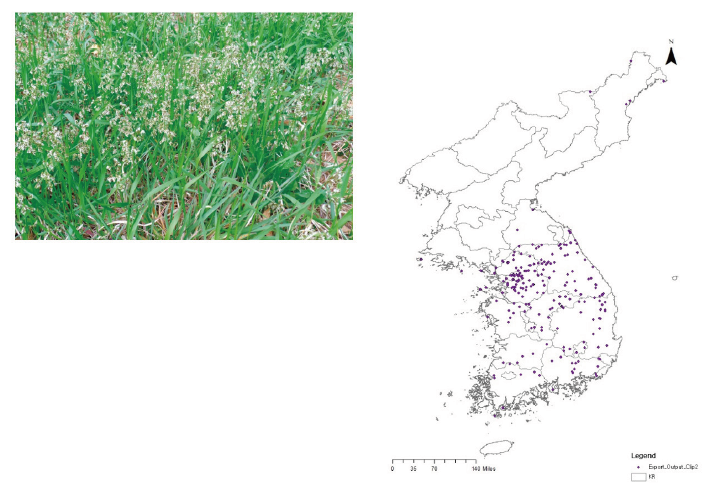
Fig. 22. Hierochloe odorata plant and the distribution map in Korea. This perennial allergic weed is usually found in orchards and flowers in April. Weed location dots on the right figure were prepared using ArcGIS (desktop version 10.8) based on the National Habitat Survey (NIE, 2016) by the National Institute of Ecology and field survey information of authors.
오리새(Dactylis glomerata L.)
오리새는 오리새속(Dactylis)에 속하는 다년생 식물로 유럽과 서아시아가 원산으로 우리나라에는 개항 이후 미국을 통해서 들어왔으며 지금은 전국으로 확산되었는데(Park, 2009), 주로 밭, 목초지, 과수원에서 발견되는 잡초이다(Lee et al., 2017b; Fig. 23). 오리새속 식물은 개방 원추화서이면서 2개의 포영이 있고 호영에 용골이 발달하며 까락이 있는 것이 특징이다. 주로 길가나 강둑에서 나며 초장은 60-120 cm이다. 원추화서는 길이 12 cm가량 되며 가지 끝에 밀집한 작은 이삭 덩이가 있다. 작은 이삭은 자루가 짧거나 거의 없고, 낱꽃은 3-4 송이이다. 개화기는 6-7월이다(Lee, 2006). 오리새 꽃가루는 단공형이고 크기는 34-40 μm이며 알레르기를 일으킨다고 알려져 있다(Hong, 2015).

Fig. 23. Dactylis glomerata plant and the distribution map in Korea. This perennial plant is native to Europe and West Asia and found in fields, pastures and orchards. Weed location dots on the right figure were prepared using ArcGIS (desktop version 10.8) based on the National Habitat Survey (NIE, 2016) by the National Institute of Ecology and field survey information of authors.
왕포아풀(Poa pratensis L.)
왕포아풀은 포아풀속(Poa)에 속하는 다년생 식물로 왕꿰미풀로도 불리는 알레르기 식물이다(Hong, 2015). 초장은 20-50 cm 정도이고 줄기는 밀생하며 곧게 선다. 원추화서는 피라미드형 또는 길 타원상 피라미드형으로 성기게 퍼지면 길이는 5-15 cm 정도이고 개화기는 5-7월이다(Lee, 2006). 왕포아풀은 유럽이 원산이며 우리나라의 전국의 밭, 목초지, 과수원에서 발견되는 외래 잡초이다(Lee et al., 2017a). 좀포아풀과는 달리 지상의 줄기는 곧게 서고 잎애의 길이가 길며 원추화서는 폭이 넓은 편이다(Park, 2009).
피(Echinochloa crusgalli [L.] Baeuvois var. frumentacea [Roxb.] Wight)
피는 피속(Echinochloa)에 속하는 일년생 식물로 논이나 목장 등 습지에서 나는 대표적인 잡초이다(Lee et al., 2017a; Fig. 24). 초장은 1-2 m에 달하며 화서는 많은 가지에 작은 이삭이 총상화서 모양으로 굵고 조밀하게 달려 원추형을 이룬다. 개화기는 8-9월이다(Lee, 2006).
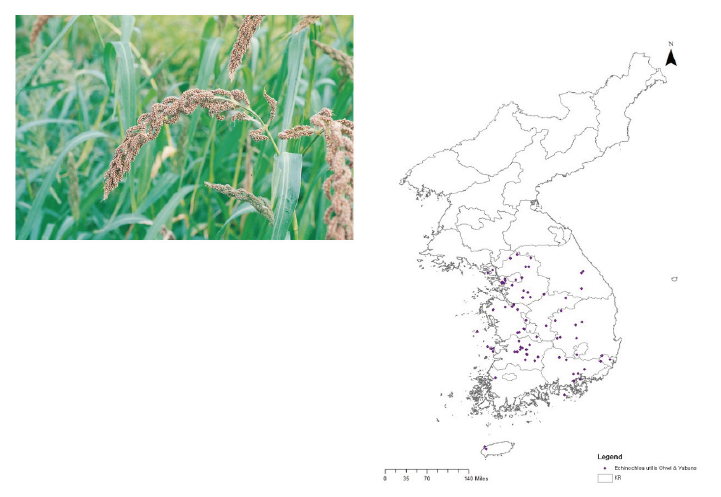
Fig. 24. Echinochloa crusgalli plant and the distribution map in Korea. This plant is a typical annual weed that grows in wetlands such as paddy fields and pastures. Weed location dots on the right figure were prepared using ArcGIS (desktop version 10.8) based on the National Habitat Survey (NIE, 2016) by the National Institute of Ecology and field survey information of authors.
금강아지풀(Setaria glauca [L.] Beauvois)
강아지풀속(Setaria)에 속하는 금강아지풀은 밭, 목장, 과수원에서 흔히 발견되는 일년생 잡초이다(Lee et al., 2017a). 초장은 50-100 cm 정도이다. 화서는 원기둥 모양이고 길이는 5-10 mm이다. 개화기는 7-8월이다(Lee, 2006).
강아지풀(Setaria viridis [L.] Beauvois)
강아지풀속(Setaria)에 속하는 강아지풀은 전국의 밭, 목장, 과수원에서 흔히 발견되는 일년생 잡초이다(Lee et al., 2017a; Fig. 25). 강아지풀은 금강아지풀과 닮았으나 화서는 푸른색 또는 자주색 강모에 싸여 있으며, 개화기는 7-8월이다.
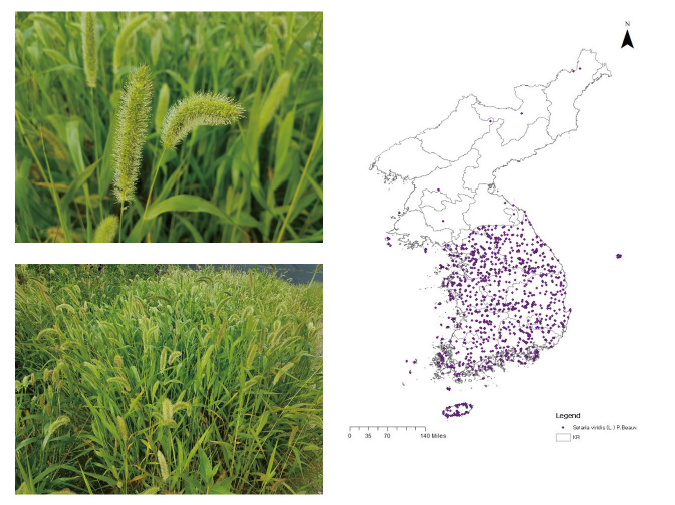
Fig. 25. Setaria viridis plant and the distribution map in Korea. This annual weed is found in fields, pastures, and orchards. Weed location dots on the right figure were prepared using ArcGIS (desktop version 10.8) based on the National Habitat Survey (NIE, 2016) by the National Institute of Ecology and field survey information of authors.
수크령(Pennisetum alopecuroides [L.] Sprengel)
수크령은 수크령속(Pennisetum)에 속하는 다년생 잡초로 전국의 과수원이나 목장의 양지바른 곳에서 흔히 발견되는데(Lee et al., 2017a; Fig. 26), 모양은 강아지풀과 같이 생겼으며 알레르기를 일으킨다고 보고되었다(Hong, 2015). 잎 가장자리에 긴 털이 나 있으며 브러시 같은 꽃 이삭을 맺는다. 화서는 원통형의 이삭화서 모양이며, 개화기는 8-9월이다(Lee, 2006).
억새(Miscanthus sinensis Andersson)
억새속(Micsanthus)의 다년생식물인 억새는 전세계적으로 17개 종이 존재하고 있으며 바이오 에너지원으로 중요한 종이다(Chen and Stephen, 2006; Moon et al., 2010). 초장이 1-2 m 정도로 크며, 화서는 부채모양으로 중축은 원추화서 길이의 1/2 기량이며 개화기는 9월이다. 억새속의 억새와 유사한 우리나라 식물로는 흰억새(M. sinensis Andersson var. albiflorus Y. Lee), 금억새(M. sinensis Andersson var. chejuensis Y. Lee), 가는잎억새(M. sinensis Andersson var. gracullius Hitchcock) 등이 있으며, 산, 하천, 간척지에서 발견된다(Lee, 2006).

Fig. 26. Pennisetum alopecuroides plant and the distribution map in Korea. This perennial plant is mainly found in sunny areas of orchards and pastures. Weed location dots on the right figure were prepared using ArcGIS (desktop version 10.8) based on the National Habitat Survey (NIE, 2016) by the National Institute of Ecology and field survey information of authors..
결론 및 시사점
일반적으로 알레르기 반응은 서구적 식습관, 대기오염원, 식물의 꽃가루 등에 의해 발생하는 것으로 알려져 있다. 잡초 중에서는 환삼덩굴, 미역취, 도꼬마리, 소리쟁이, 명아주, 비름, 질경이의 꽃가루는 알레르기를 일으킨다는 보고가 있었기에(Hong, 2015), 알레르기란 무엇이며, 국내에서 알레르기를 일으켜 인류 건강을 위협하는 잡초 종류와 그 특성을 조사하였다.
알레르기는 정상적인 면역계에서 과도한 형태나 또는 비정상적으로 일어나는 반응이다. 주로 제1타입의 과민반응을 알레르기라고 하는데 잡초의 꽃가루가 인체내로 유입되면 IgE 고친화성 수용체인 FcεRI에 결합하여 알레르기 반응기작이 이루어진다. 수지상세포가 T세포로 항원을 전달하는 과정에서 사이토카인에 의해 각기 다른 역할을 하는 T 세포로 분화하는데 면역반응이 유도되어 감작단계, 활성화단계, 효과단계를 거쳐 신체내에서는 기관지천식, 알레르기 결막염, 부비동염, 중이염, 수면장애 등 여러 질환이 동반된다.
우리나라에는 약 4,500여종의 식물이 서식하고 있고(Lee, 2006), 이 중 잡초로 분류된 것은 1,400여 종이다(Oh, 2003). 잡초는 인간의 삶과 함께 하고 있으며, 우리의 삶은 잡초로부터 크게 벗어날 수 없다. 현재까지 과학저널에 발표된 내용에 따르면 모든 잡초가 알레르기를 일으키는 것은 아니고 IgE가 친화성 수용체인 FcεRI에 결합하여 알레르기 반응을 개시하는 꽃가루를 갖는 잡초만이 알레르기 반응을 일으킨다. 꽃가루 알레르기를 일으키는 잡초들은 환삼덩굴속, 소리쟁이속, 명아주속, 비름속, 질경이속, 해바라기속, 돼지풀속, 도꼬라미속, 미역취속, 개망초속, 쑥속, 화본과에 속하는 것들이 보고되어 있다.
같은 속에 속하는 식물들은 유전적으로 매우 유사하며, 알레르기 반응 역시 동속 식물에서 교차반응을 일으키는 것으로 보고되었다. 이런 결과로 미루어 알레르기 반응을 일으킨 식물에 속한 다른 식물들 역시 알레르기 반응을 일으킬 가능성이 높다고 판단된다.
알레르기를 일으키는 것으로 잘 알려진 돼지풀과 단풍잎돼지풀은 초롱꽃목(Campanulales), 국화과 돼지풀속에 속한다. 돼지풀속에는 북미, 유럽, 아시아에만 약 43여종이 존재하고 있다. 돼지풀과 단풍잎돼지풀이 알레르기를 일으킨다면 유전적으로는 매우 유사한 돼지풀속의 식물인 Ambrosia chiensis, A. elata, A. elatior, A. glandulosa, A. monophylla, A. paniculata, A. peruviana 역시 알레르기를 일으킬 가능성이 있다고 추론된다. 이러한 추론이 과학적으로 증명된다면 꽃가루 알레르기를 일으키는 식물 속에 포함된 대부분이 알레르기를 일으킬 수 있다고 보인다. 향후 외래식물 도입심사 과정에서 알레르기 양성반응을 보이는 외래식물은 국민건강 예방 차원에서 검토가 이루어져야 할 것이다.
지구온난화가 가속됨에 따라 생태계 교란 등 생물다양성에 심각한 영향이 우려되고 있다. 기후변화에 따라 식물의 생태적 변이가 일어나는 것에 대해서는 의심할 여지가 거의 없는데(Jang et al., 2011; Primack, 2008), 같은 식물이라도 서식지의 위치에 따라 생태적, 종간, 종내 변이가 일어날 수도 있고 선택 압(selection pressure)이나 진화 압(evolutionary pressure)이 일어날 수 있다. 지구온난화로 인한 식물변이는 알레르기 항원의 변이에도 영향을 줄 수 있고, 변이는 알레르기 반응에 영향을 줄 수 있으므로 이에 대한 면밀한 연구가 필요할 것이다.
동일한 식물 속 중에는 유전적으로 매우 유사한 종들이 존재한다. 이런 잡초 혹은 식물의 정보는 향후 외국으로부터 도입가능성이 있는 외래식물/잡초의 도입을 심사하는 과정에서도 유용하게 활용될 수 있을 것이다. 전세계적으로 알레르기를 일으킨다고 보고된 식물이 우리나라로 도입될 때에는 외래식물에 대한 위해성 여부를 조사하게 되는데 알레르기 여부도 반드시 체크가 되어 국민 건강에 악영향을 일으키지 않아야 할 것이다.
잡초는 『원하지 않는 곳에서 원하지 않는 시기에 자라는 식물, 이용가치가 아직까지 발견되지 않은 식물, 농업생산성을 낮추는 식물, 또는 인간의 활동에 방해가 되는 식물』로 인간의 가치판단에 따라 정의된다. 또한 『외부 간섭이나 생존지역의 파괴가 추가되지 않은 환경에서 서식하는 식물, 또는 끊임없이 교란되고 물리적 환경요인의 변화에 직면하여 매우 불안정한 환경에 서식하는 식물』로 생물학적 판단에 따라 정의되기도 한다. 그럼에도 불구하고 현재 한국잡초학회에 소속된 대부분의 잡초과학자들에게 있어서 잡초는 단지 농업생산성 보호에만 맞춰져 있는 것은 주지의 사실이다.
현재 잡초학회에서 발간되는 WTS 저널에서는 잡초가 인간에게 미치는 영향에 관한 연구는 거의 다뤄지고 있지 않는데, 이는 병리학자, 독성학자, 의과학자나 전문 의료인과 같이 인간의 건강과 밀접한 연구를 수행하는 연구자들이 잡초학회에서 활동하고 있지 않기 때문일 것이다. 따라서 잡초의 위해성을 농업분야에만 국한시키지 말고, 일반인들이 관심을 더 많이 갖는 건강문제와 연계한다면, 잡초와 잡초 방제 분야는 물론 잡초학자들에 대한 사회적인 관심이 더 높아질 것이다.
지금처럼 잡초 연구자들의 연구범위를 잡초-작물 혹은 잡초-생태환경에만 제한한다면 과거와 같은 사회적인 이슈를 만들지 못할 것이고, 결국에는 새로운 연구자의 유입과 같은 인적쇄신, 잡초 연구를 위한 연구비의 유입이 둔화되어 잡초학회의 활동에도 제한이 있을 수 밖에는 없을 것이다.
현재 우리사회는 선진국으로 진입하였음은 물론, 100세 시대에 다가서고 있어 국민 건강이 무엇보다 큰 사회적 관심사이다. 이에 따라 잡초 연구자들의 연구범위가 잡초-인간 건강으로까지 확대되기를 기대해 본다.
요 약
전 세계적으로 많은 사람들이 잡초의 꽃가루로 인해 알레르기 결막염, 비염, 천식, 아나필락시스 등 다양한 알레르기 관련 질환으로 고통받고 있으며, 한국 인구의 30% 이상이 꽃가루 알레르기를 앓고 있는 것으로 보고되고 있다. 공중 보건에 대한 악영향에도 불구하고 알레르기 잡초와 한국 내에서의 분포에 대해서는 알려진 바가 거의 없기에 저자들은 알레르기의 작용기전, 알레르기를 유발하는 국내 잡초와 국내에서의 분포, 그리고 알레르기 유발 잡초가 주는 시사점을 소개한다. 잡초에 의해 발생하는 알레르기성 질환은 일반적으로 꽃가루로 인해 발병하며, 현재 미세먼지와 꽃가루 수가 증가함에 따라 실제로 알레르기성 비염의 진단율은 가파르게 상승하고 있다. 알레르기 잡초가 국민건강에 미치는 경제·사회적인 영향은 매우 크기에, 본 리뷰에서는 이와 같은 알레르기 질환을 유발하는 환삼덩굴속(Humulus), 소리쟁이속(Rumex), 명아주속(Chenopodium), 댑싸리속(Kochia), 갯능쟁이속(Atriplex), 비름속(Amaranhus) 질경이속(Plantago depressa), 돼지풀속(Ambrosia), 도꼬마리속(Xanthium), 미역취속(Solidago), 개망초속(Erigenom), 쑥갓속(Chrysanthemun)에 속하는 식물들에 대해 다루었으며, 이들과 같은 알레르기 잡초는 향후 한국 잡초학회 회원들의 주요 연구 주제가 될 것이라 기대된다.
주요어: 국민건강, 알레르기, 알레르기 잡초
Acknowledgement
This work was supported by the Korean Ministry of Environment (Grant no. 2018002270002).
Authors Information
Minju Kim, Kangwon National University, Ph.D. student
So-Yeon Kim, Kangwon National University, Ph.D. student
Geun Jung Jang, Kangwon National University, Researcher
Yong Ho Lee, Hankyong National University, Post-doctoral Fellow
Sun Hee Hong, https://orcid.org/0000-0001-7581-0604
Songmun Kim, https://orcid. org/0000-0002-8032-7569

